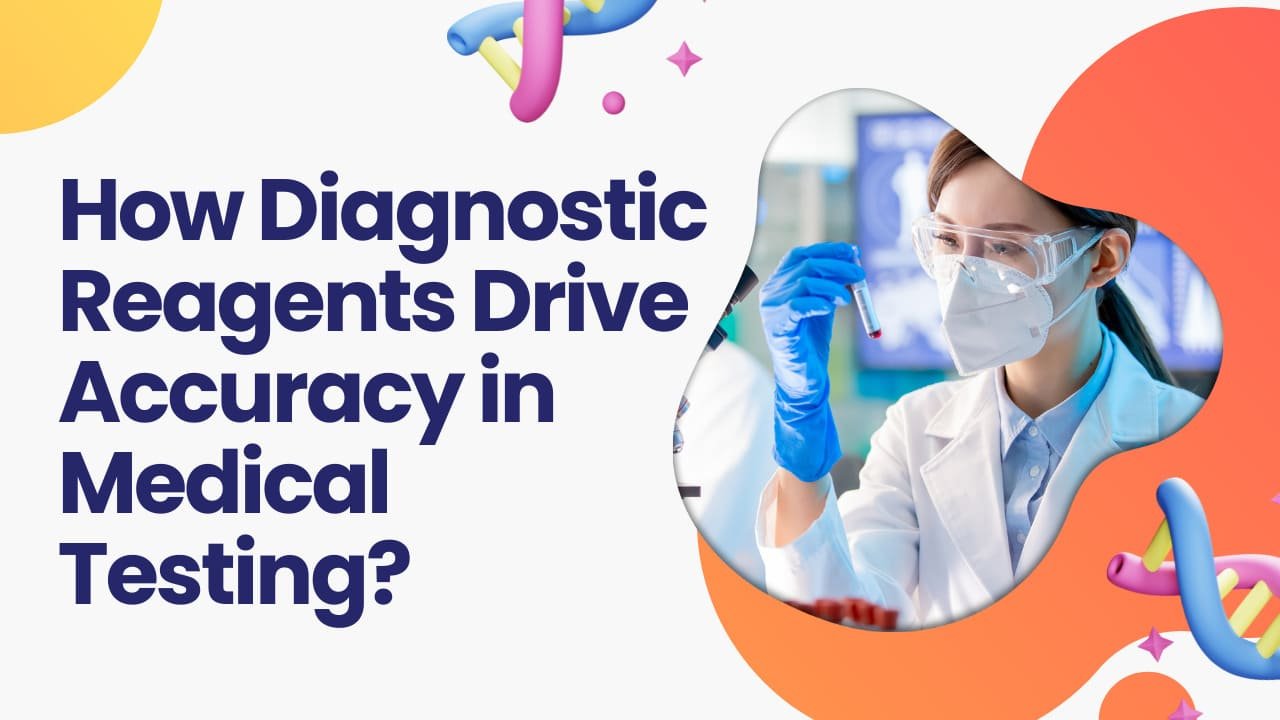Medical diagnostics rely on precise and reliable testing to detect diseases, monitor conditions, and guide treatments. One of the key components ensuring this accuracy is diagnostic reagents specialized chemical substances used in laboratory tests to identify biological markers.
From detecting infections and chronic diseases to guiding personalized medicine, diagnostic reagents play a vital role in modern healthcare. This article explores their types, functions, significance, and future advancements shaping diagnostic accuracy.
What Are Diagnostic Reagents?
A diagnostic reagent is a chemical or biological substance used in clinical and laboratory tests to detect, measure, or analyze biological components such as proteins, enzymes, hormones, pathogens, or genetic material. These reagents react with specific analytes to produce detectable signals, allowing healthcare professionals to diagnose diseases and monitor treatment progress.
Key Characteristics of Diagnostic Reagents
- Specificity– Targets specific biomarkers for precise identification.
- Sensitivity– Detects even minute concentrations of substances in a sample.
- Stability– Maintains effectiveness under storage and testing conditions.
- Reproducibility– Delivers consistent results across multiple tests.
Types of Diagnostic Reagents
1. Immunoassay Reagents
Used in antibody-antigen interactions, these reagents help detect infections, hormonal imbalances, and autoimmune diseases.
- Examples: ELISA kits, and lateral flow assay reagents (used in pregnancy tests and COVID-19 rapid tests).
- Applications: HIV testing, hormone level detection, viral infections.
2. Molecular Diagnostic Reagents
These reagents help identify genetic material (DNA/RNA) of pathogens or mutations in genes.
- Examples: PCR (Polymerase Chain Reaction) primers, nucleotides, and fluorescent probes.
- Applications: COVID-19 detection, cancer genetic testing, hereditary disease screening.
3. Hematology Reagents
Used in blood analysis to count cells and detect abnormalities.
- Examples: Red and white blood cell reagents, and hemoglobin reagents.
- Applications: Complete Blood Count (CBC), anemia detection, leukemia diagnosis.
4. Biochemical Reagents
Analyze metabolic functions and enzyme activity in bodily fluids.
- Examples: Glucose oxidase, cholesterol reagents, and creatinine reagents.
- Applications: Diabetes monitoring, kidney function tests, liver function tests.
5. Microbiology Reagents
Aid in culturing, identifying, and testing bacteria and fungi for antibiotic resistance.
- Examples: Culture media, Gram stain reagents, and antimicrobial susceptibility tests.
- Applications: Bacterial infection diagnosis, tuberculosis testing, food safety analysis.
6. Coagulation Reagents
Assess blood clotting functions, crucial for detecting clotting disorders like hemophilia.
- Examples: Prothrombin Time (PT) reagents, and activated Partial Thromboplastin Time (aPTT) reagents.
- Applications: Blood clotting disorder screening, monitoring anticoagulant therapy.
How Do Diagnostic Reagents Improve Medical Testing Accuracy?
1. Early Disease Detection
Diagnostic reagents detect diseases at an early stage, improving treatment outcomes. For example:
- Tumor marker reagents identify cancer early.
- PCR reagents detect viral infections before symptoms appear.
2. Precision and Reliability
Modern reagents offer high specificity and sensitivity, reducing false positives and negatives.
- Example: High-sensitivity cardiac troponin reagents help diagnose heart attacks accurately.
3. Real-Time Monitoring
Diagnostic reagents allow continuous monitoring of chronic conditions, ensuring timely intervention.
- Example: Blood glucose test strips for diabetes management.
4. Personalized Medicine
Molecular diagnostic reagents analyze genetic variations, enabling tailored treatments.
- Example: BRCA gene testing for breast cancer risk assessment.
5. Rapid Results in Point-of-Care Testing
Many diagnostic reagents enable fast, on-site testing without the need for lab infrastructure.
- Example: COVID-19 antigen tests provide results in minutes.
Applications of Diagnostic Reagents in Healthcare
1. Infectious Disease Testing
- Detects bacterial and viral infections such as HIV, tuberculosis, and COVID-19.
- Used in screening blood donors for transfusion safety.
2. Cancer Diagnostics
- Identify cancer biomarkers for early detection and treatment planning.
- Used in liquid biopsy to detect circulating tumor DNA (ctDNA).
3. Endocrinology and Hormone Testing
- Measures hormone levels to diagnose thyroid disorders, diabetes, and reproductive health issues.
- Used in fertility treatments and pregnancy monitoring.
4. Autoimmune Disease Testing
- Detects abnormal immune responses in conditions like lupus and rheumatoid arthritis.
- Utilizes ELISA and immunofluorescence assays.
5. Cardiac Health Monitoring
- Identifies heart disease markers like troponin, CK-MB, and BNP.
- Helps in risk assessment and emergency response for cardiac events.
Recent Advances in Diagnostic Reagents
1. AI and Machine Learning in Diagnostic Reagents
- AI enhances reagent-based testing by analyzing complex data patterns.
- Example: AI-powered blood smear analysis improves leukemia detection.
2. CRISPR-Based Diagnostics
- Uses gene-editing technology for rapid and precise disease detection.
- Example: SHERLOCK and DETECTR platforms detect COVID-19 and Zika virus.
3. Multiplex Reagent Technologies
- Allow simultaneous detection of multiple diseases from a single sample.
- Example: Respiratory pathogen panels identify flu, RSV, and COVID-19 in one test.
4. Nanotechnology in Diagnostic Reagents
- Nano-reagents improve sensitivity and reduce testing time.
- Example: Gold nanoparticles enhance rapid lateral flow tests.
Challenges in Diagnostic Reagent Development
1. Stability and Storage Issues
- Many reagents require strict temperature control to remain effective.
- Solution: Advancements in lyophilization (freeze-drying) technology improve reagent shelf life.
2. Cost and Accessibility
- High-quality reagents are often expensive, limiting access in low-resource settings.
- Solution: Initiatives for affordable, scalable reagent production are underway.
3. Regulatory Compliance
- Diagnostic reagents must meet stringent FDA, CE, and WHO standards.
- Solution: Standardized quality control ensures accuracy and safety.
Conclusion
Diagnostic reagents are at the heart of medical testing, ensuring accurate disease detection, treatment planning, and health monitoring. With continuous advancements in biotechnology, future diagnostic reagents will be even more precise, affordable, and accessible, revolutionizing healthcare globally.
By improving speed, reliability, and accessibility, these reagents will continue to drive medical innovation, ultimately saving lives and enhancing patient insale.kiev.








